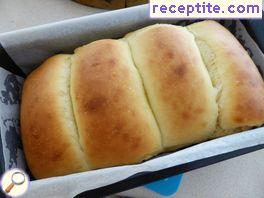Ingredients
# For tangzhong:
100 ml water
25 g flour (2 tbsp tipped, but not too overbought)
# For the dough:
1 egg
1 tsp dry yeast or 10 g fresh
70 ml cream
1 tsp - 5 tbsp sugar
1 tsp salt
30 ml warm water
2 cup flour
30 g butter

Photo added on
Photo author
xevi
Method
First prepare the mixture tangzhong - water and flour mix in bowl and mix with wire so that no lumps. Put it on low heat and stir in a few minutes begins to thicken and then, stirring constantly, keep the stove for about 3 minutes. It should be a smooth thick mixture by lifting the wire / spoon to form a soft tips - see picture 1. The temperature should be 65C, you can measure with an appropriate thermometer, if desired, but not required . The mixture is placed in the refrigerator to cool for at least an hour after it is completely cold and can be kept 1-2 days in the refrigerator. In a bowl, put 1 cup flour, yeast, salt and sugar and mix well. If you use fresh yeast or dry, which needs the dissolution in water disperse it in 30 ml warm water. In another bowl put the egg, cream and 30 ml water (if you have not put in yeast), beat lightly with a spoon. Pour the wet ingredients to the flour mixture tangzhong and mix with a spoon, add flour mixture until thick, then knead a soft dough. Knead the dough 5 minutes, then add the soft butter and knead for several minutes. Place the dough in a bowl and leave to rise until doubled in volume. The risen dough mix again for 1-2 minutes, then divide into 4 balls. Each roll of a rectangle (about 15x20 cm). Fold back the two sides of the rectangle lengthwise so as to meet in the middle and rolled on the long side (picture 3). The resulting roll cover with a cloth and leave for 10 minutes. Then each roll roll along, and again roll (photos 4 and 5). Rolls arrange in advance greased or littered with baking paper form (22h12 cm). Leave in a warm place to rise until doubled in volume. Leavened bread can brush with beaten egg yolk, then bake in a preheated oven at 170-180C for 15 minutes, then remove and wrap with aluminum foil to remain mekichka crust and bake another 20 minutes. * thus prepared bread is very soft and fluffy and remains so for a long time. * The amount of sugar is to taste - 1 tbsp like normal bread, 3 tbsp slightly sweet, with 5 tbsp more sweet, but not too, can be served with savory food. * 1 cup = 250 ml
Containers:
Difficulty
Difficult
Tested
0 users
Source
http://yireservation.com/recipes/soft-asian-milk-bread/

Comments
Well, bravo! From when I want to do it! I recorded it as a *Japanese Hokkaido milk bread,* I have 3 raznoezichni recipes and still can not find the time to translate them and compare! :) And you me Floral voila! :) Nevi, thanks!
Ina, I'm glad you interesting :) This recipe is not exactly Hokkaido - it has a little more sugar and milk is used, but is very similar and this method with boiled flour used in both.
An interesting way of making bread, what is it the role of cooked dough, albeit a small amount, perhaps it becomes very fluffy bread.
color, I'm not quite sure of the chemistry of the process, but, heating the mixture to 65C and then using it in the dough makes it fluffy and soft.
Nevi, there really is little difference. The method is the same. Only how to determine when they were 65 degrees? If anyone knows a practical way, please share! :)
Ina, drive as I described it - messing low heat begins to thicken, stirring for an additional 2-3 minutes until mixture thickens and pick up the spoon to form a soft tips. You can check out picture 1, there I tried to see how it changes the mixture until it thickens. Not necessarily exactly 65C, just what is the temperature at which the change in the flour. Twice already do bread - once I get more dense, other more rare mixture (I kantarche for flour), the first time we heat up to over 70C, second again hardly was just 65 - and both times the bread became perfect, so the nearest clearly enough :)
Oh, if you have a thermometer (cooking) can measure temperature, but the mixture is so small (low), it is difficult not to touch the bottom and therefore does not measure accurately. However, as I said - is not at all difficult to make eye :)
When making bread starch (starch) in flour is associated with the water in the dough to form a soft fluffy structure of the finished bread and dough proteins bind with water and make gluten - which is the supporting structure. Upon slow heating of the flour with water, starch (starch) in the flour is reacted with water, swells and 65C gelled, holding the water molecules and stops them from evaporating and simultaneously in the mixture to form gluten (which is formed by mixing proteins with water, but in this case the water is absorbed by the starch). By replacing part of the flour and water into dough tangzhong in the dough a bit more water, a little more swollen starch and a little less gluten - these three factors are what makes the dough more fluffy and soft.
Generally any dough can be made by this method, just part of the flour and the water used are replaced with cooked mixture. Recommended quantities found on various websites are replacing 5-10% of the flour in the recipe. If anyone is interested can write to me personally, not to dilute the comments.